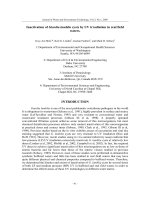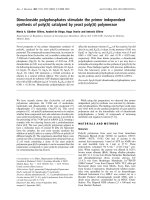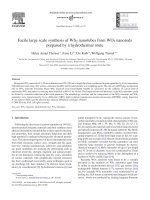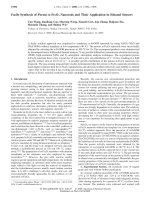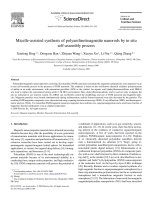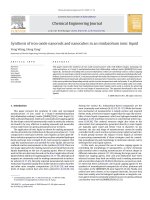- Trang chủ >>
- Khoa Học Tự Nhiên >>
- Vật lý
micelle-assisted synthesis of polyaniline magnetite nanorods by in situ self - assembly process
Bạn đang xem bản rút gọn của tài liệu. Xem và tải ngay bản đầy đủ của tài liệu tại đây (403.21 KB, 5 trang )
Journal of Colloid and Interface Science 320 (2008) 341–345
www.elsevier.com/locate/jcis
Micelle-assisted synthesis of polyaniline/magnetite nanorods by in situ
self-assembly process
Xuefeng Ding
a,1
, Dongxue Han
a
, Zhijuan Wang
a
, Xiaoyu Xu
a
,LiNiu
a,∗
, Qiang Zhang
b,∗
a
State Key Laboratory of Electroanalytical Chemistry, Changchun Institute of Applied Chemistry, Chinese Academy of Sciences, Changchun 130022, PR China
b
Department of Chemistry, College of Science, Beijing Institute of Technology, Beijing 100081, PR China
Received 21 September 2007; accepted 5 January 2008
Available online 10 January 2008
Abstract
Polyaniline/magnetite nanocomposites consisting of polyaniline (PANI) nanorods surrounded by magnetite nanoparticles were prepared via an
in situ self-assembly process in the presence of PANI nanorods. The synthesis is based on the well-known chemical oxidative polymerization
of aniline in an acidic environment, with ammonium persulfate (APS) as the oxidant. An organic acid (dodecylbenzenesulfonic acid, DBSA)
was used to replace the conventional strong acidic (1 M HCl) environment. Here, dodecylbenzenesulfonic acid is used not only as dopant, but
also as surfactant in our reaction system. So, DBSA can excellently control the morphology and size of PANI nanorods and magnetite parti-
cles. Magnetite particles were formed simultaneously during sedimentation, and the formed nanorods were also decorated by the particles. The
resulting PANI/magnetite composites were characterized using scanning electron microscopy (SEM), X-ray diffraction (XRD), and thermogravi-
metric analysis (TGA). It is found that PANI/magnetite nanorod composites have uniform size, superparamagnetism and a small mass fraction of
magnetite, thermal stabilization even at a higher temperature.
© 2008 Elsevier Inc. All rights reserved.
Keywords: Magnetic properties; Micelles; Nanorods; Polymerization; Self-assembly
1. Introduction
Magnetic nanocomposite materials have attracted increasing
attention because they offer the possibility of a new generation
of nanostructure materials with diverse applications for immu-
nity assay [1], separation and purification of biomolecules [2,3],
extensive researches have been carried out to develop super-
paramagnetic organic/inorganic hybrid spheres for biomedical
applications, as carriers for targeted drug delivery [4], biomag-
netic separations, and biosensors [5–9].
Polyaniline (PANI) is one of the most technologically im-
portant materials because of its environmental stability in a
conducting form, unique redox properties, and high conductiv-
ity [10]. PANI composite materials will possess the potential of
*
Corresponding authors. Fax: +86 431 8526 2800.
E-mail addresses: (L. Niu),
(Q. Zhang).
1
Also working in College of Chemistry, Jilin University, Changchun 130021,
PR China.
a multitude of applications, such as in gas sensitivity, sensors,
and inductors [11–13]. In recent years, there has been increas-
ing interest in the synthesis of conductive organic/inorganic
nanocomposites. A few of works had been reported on the
synthesis PANI/inorganic nanocomposites [14–16]. Hopkins
et al. chemically deposited polyaniline nanofibers directly
onto a functionalized Au substrate [17]. Yang’s group re-
ported polyaniline nanofiber/gold nanoparticles device with a
nonvolatile plastic digital memory [18]. Kleinermanns et al.
synthesized dispersed polyaniline (PANI)-Au composite parti-
cles with a core–shell structure by direct oxidation of aniline us-
ing AuCl
−
4
as the oxidant [19]. Luca et al. described how to ma-
nipulate and build V
2
O
5
/polyaniline (PANI) nanocomposites
at the molecular level via the layer-by-layer (LBL) technique
[20]. Recently, Ramírez and co-workers reported synthesis of a
high magnetite fraction in superparamagnetic nanospheres by a
three-step miniemuslion polymerization, but the as-synthesized
nanospheres had a nonuniform magnetite fraction in each
nanosphere [21,22]. The fabrication of nanosized ferromagnetic
magnetite/polyaniline nanoparticles (NCs) had been described
0021-9797/$ – see front matter © 2008 Elsevier Inc. All rights reserved.
doi:10.1016/j.jcis.2008.01.004
342 X. Ding et al. / Journal of Colloid and Interface Science 320 (2008) 341–345
by oxidatively polymerizing aniline using ammonium perox-
odisulfate as oxidant (NH
4
)
2
S
2
O
8
[23]. There, the obtained
NCs with 20–30 nm average diameter were polydisperse, and
show a core–shell structure. Aminabhavi et al. [24] reported
novel high dielectric constant Fe
2
O
3
/PANI nanocomposites
particles. Xu et al. [25] synthesized magnetite/poly(styrene-co-
maleic anhydride) magnetic composite microspheres to immo-
bilize amylase. Despite a few of papers concerning the prepa-
ration of magnetite nanocomposites and their applications in
biomedicines, their practical application is still limited. Usually
an external magnetic field was used to suspend paramagnetic
particles in biomaterial applications, and the resulting materi-
als were expected to do not agglomerate anymore after removal
of the field. At present, the significant question is that magnetic
particles can easily aggregate in the presence or even the ab-
sence of a magnetic field. Furthermore, the major difficulty lies
in the interrelated effects in synthesis and assembly. Agglom-
eration of these particles originates from the strong interaction
among the particles, which will diminish their magnetic prop-
erties. Therefore, it is of fundamental importance to develop a
method to synthesize novel morphology composites with a high
mass fraction of magnetite.
In this paper, we report a facile one-pot synthesis of
PANI/magnetite nanorod composites through DBSA micelle-
assisted synthesis by in situ self-assembly method. The pres-
ence of a high concentration of DBSA can effectively prevent
the formation of larger particles, thereby producing nanometer-
sized particles only. PANI nanorods and magnetite nano-
particles can form stable nanocomposites. PANI/magnetite
nanorod composites have uniform size, superparamagnetism,
thermal stabilization even at a higher temperature.
2. Materials and methods
2.1. Materials
Aniline was obtained from Beijing Xingjin Chemical Fac-
tory, and was distilled at a reduced pressure before use. DBSA
(Anyang Xingya Chem. Ltd.) was used as the surfactant and
dopant. Ammonium persulfate [APS, (NH
4
)
2
S
2
O
8
, Beijing
Chemical Factory], Ferric chloride hexahydrate (FeCl
3
·6H
2
O,
Beijing Tonghui Chem. Reagent Factory), and Iron (II) sulfate
heptahydrate (FeSO
4
·7H
2
O, Tianjin Bodi Chem. Ltd.) were
used as received. Water was distilled before use. And all other
reagents were analytical grade and used without further purifi-
cation.
2.2. Synthesis of DBSA-Doped PANI
The doped PANI was synthesized using the HCl as dopant.
The DBSA-doped PANI with nanorods structure was synthe-
sized as follow. In a typical experiment, 5 ml of DBSA and
0.093 g of purified aniline were dissolved in 50 ml of distilled
water in a three-necked round-bottom flask at room tempera-
ture. DBSA were used as the surfactant and dopant. This so-
lution was purged with nitrogen for 30 min and was quickly
cooled to 0–4
◦
C using the ice-water bath. Then, 1 ml of
1mol/L aqueous solution of ammonium persulfate (used as
the oxidant) was added under vigorous stirring. After a few
minutes, a green precipitate formed. During the polymerization
process, it was observed that the color of the solution changed
to dark green. The whole polymerization reaction was carried
out at 0–4
◦
C for 5 h. Finally, the DBSA-doped PANI was ob-
tained.
2.3. Synthesis of PANI/magnetite nanorods
The10mlof1mol/L FeCl
3
·6H
2
O and 10 ml of 0.5 mol/L
FeSO
4
·7H
2
O aqueous solution were then rapidly added into the
above polymerization reaction, respectively. This solution was
purged with nitrogen to remove all traces of oxygen and was
slowly heated up to 60
◦
C under magnetic stirring. Then, 5 ml
of 25% NH
3
·H
2
O were rapidly added. The entire reaction sys-
tem became black. After 5 h, the emulsion of PANI/magnetite
nanorods were obtained. The resulting precipitate was centrifu-
gated to separate the byproducts (inorganic salts, oligomers,
etc.), washed/centrifugated with deionized water and methanol
for several times. Finally, the pure dark precipitate was dried at
50
◦
C under vacuum for 12 h.
2.4. Characterizations
The morphology of the nanocomposite particles was inves-
tigated by scanning electron microscopy (SEM) (JEOS JSM-
5600). Thermogravimetric analysis (TGA) of the nanocom-
posites particles was performed on TGA/SDTA851
e
analyzer
at a heating rate of 10
◦
Cmin
−1
from 50–800
◦
C under an
atmosphere flow. X-ray diffraction analysis of the samples
was carried out using an X-ray diffractometer (XRD, Model
D/MAX2500, Rigaka) with Cu KR radiation.
3. Results and discussion
Fig. 1 illustrates the synthesis process of PANI/magnetite
nanorods. The synthesis is based on the well-known chemi-
cal oxidative polymerization of aniline in an acidic environ-
ment, with ammonium persulfate as the oxidant. Here we use
an organic acid (DBSA) instead of conventional strong acids
(such as HCl). DBSA is used not only as the dopant, and also
as the surfactant, which can control the morphology of PANI
nanorods and magnetite particles. A scheme of the possible
synthesis mechanism of the composite particles is shown in
Fig. 1. By taking advantage of the micelle reaction system,
we firstly obtained colloidal PANI doped with DBSA by the
one-step chemical oxidative polymerization of aniline in the
presence of micelles of DBSA. Micelle-assisted synthesis had
previously been used widely to prepare polymer particles in
which the particle sizes were controlled by the micelle “reactor”
sizes [26]. The presence of a high concentration of DBSA can
prevent the formation of larger particles, thereby only produc-
ing nanometer-sized particles. The PANI nanorods have nearly
uniform diameters and lengths by using DBSA. Second, mag-
netite particles were easily formed inside micelle “reactor” dur-
ing sedimentation process and decorated the nanorods through
X. Ding et al. / Journal of Colloid and Interface Science 320 (2008) 341–345 343
Fig. 1. Schematic illustration of the synthesis process of PANI/magnetite nanorod composites.
such reverse micelles. And PANI/magnetite nanocomposite
materials could be readily obtained by such a self-assembly
process in the presence of PANI nanorods. Moreover, it is worth
noticing that the resulting PANI/magnetite nanocomposites can
form stable nanorods with uniform size and high yields, and
also show good superparamagnetism.
Fig. 2 gives typical SEM images of the resulting PANI/mag-
netite nanorods prepared by in situ self-assembly method. As
shown in Fig. 2A, PANI/magnetite nanorods has an unique
nanorods structure in shape, ca. 80 nm in diameter and ca.
600 nm in length. It is clear that a great number of nano-
particles adsorbed on the surface of the PANI nanorods. The
small particles are magnetite nanoparticles derived from sed-
imentation. Furthermore, we further magnify the micrograph
of Fig. 2A. The morphology of PANI/magnetite nanorods can
be distinctly observed. As shown in Fig. 2B, there are several
PANI/magnetite nanorods in this micrograph, but it includes all
features of its regular forms. PANI/magnetite nanorods have
nonslippery surface, which are surrounded by magnetite par-
ticles on the surface. The magnetite nanoparticles are spherical
shape with 20 nm diameter.
X-ray diffraction (XRD) patterns of magnetite (curve a),
PANI/magnetite (curve b), and PANI (curve c) nanoparticles
were shown in Fig. 3. Scan range is ranging from 20.00
◦
to
80.00
◦
. Curve a showed diffraction peaks at 2θ = 30.1
◦
, 35.5
◦
,
43.2
◦
, 57.1
◦
, 62.7
◦
, which can be indexed to (220), (311), (400),
(511), and (440) planes of magnetite, respectively. According
to the reflection peaks in this figure, the main phases can be
indexed as magnetite, which are in good agreement with the
magnetite standard (Card No. PDF#01-1111). Curve c showed
that PANI nanorods had amorphous structure. The XRD pattern
of PANI/magnetite was shown as curve b. Clearly, the diffrac-
tion peaks of PANI/magnetite nanoparticles are similar to that
Fig. 2. Typical SEM images of PANI/magnetite nanorod composites.
for magnetite nanoparticles (as shown in curve a). But, the in-
tensity of diffraction peaks from PANI/magnetite is quite dif-
ferent from that from pure magnetite nanoparticles. The results
344 X. Ding et al. / Journal of Colloid and Interface Science 320 (2008) 341–345
Fig. 3. XRD patterns of (a) magnetite, (b) PANI/magnetite nanorod composites,
and (c) polyaniline nanorods.
Fig. 4. Magnetic hysteresis loop of PANI/magnetite nanorod composites mea-
sured at room temperature.
confirmed that the PANI/magnetite nanorods had been obtained
successfully.
Fig. 4 shows the magnetic hysteresis loop of PANI/magnetite
nanorod sample. Magnetic property of the sample was mea-
sured at room temperature. The hysteresis loop of the PANI/
magnetite nanorods shown in Fig. 4 revealed a ferromagnetic
behavior with saturation magnetization (Ms) and coercivity
(H c) values of ca. 17.73 emu/g and 63.8 Oe, respectively.
The Ms value of PANI/magnetite nanocomposites is much
lower than those of the pure magnetite nanoparticles. As seen
in Fig. 2A, the small particles were magnetite nanoparticles,
which adsorbed on the surface of the PANI nanorods. PANI
nanorods in such composite structure restricted the random
movement and interactions of the magnetite particles. There-
fore, we considered that the remarkable decrease of Ms values
should be attributed to the formation of many magnetite par-
ticles absorbed on the surface of PANI nanorods. As shown
in Fig. 4, the magnetic hysteresis loops of PANI/magnetite
nanocomposites sample are S type curve through coordinate
origin, no such/typical hysteresis loop can be observed at this
moment. The results indicate PANI/magnetite nanocomposites
particles have the property of superparamagnetism. Moreover,
Fig. 5. TGA curves of (a) the pure PANI and (b) the PANI/magnetite nanorod
composites under atmosphere flow at a heating rate of 10
◦
Cmin
−1
.
it is revealed that the diameter of magnetite particles is very
small and has spinelle structure. It is also consistent with our
observation in TEM micrograph.
Fig. 5 shows the TGA curves of the pure PANI and
PANI/magnetite nanocomposites under atmosphere flow at a
heating rate of 10
◦
Cmin
−1
from 50 to 800
◦
C. Three main in-
flection regions can be observed. The first region at lower tem-
peratures (<200
◦
C) is originated from loss of absorption water
and methanol. The second region at higher temperature (200–
499
◦
C) is associated with the decomposition of PANI. As seen
from the TGA curves, the rate of weight loss of PANI (curve a)
is much fast, the residue of PANI is 44.06%; while the rate
of weight loss of PANI/magnetite nanocomposites (curve b)
is slower, the residue of PANI/magnetite nanocomposites is
64.23%. In the third region (499–682
◦
C), the rate of weight
loss of PANI (curve a) is similar with that of PANI/magnetite
nanocomposites. The final residue of PANI is 0.53%, while
the final residue of PANI/magnetite nanocomposites is 9.30%.
The results reveal that the inlaid magnetite nanoparticles retard
the thermal decomposition of the polymer chain of PANI at
higher temperature (<499
◦
C). The mass fraction of magnetite
in PANI/magnetite nanocomposites is ca. 9%. And the mass
fraction of magnetite can be further increased by increasing the
thickness of magnetite coating.
4. Summary
In summary, PANI/magnetite nanorod composites were syn-
thesized through DBSA micelle-assisted self-assembly method.
PANI nanorods and magnetite nanoparticles can form stable
nanocomposites. SEM images clearly show that the magnetite
particles absorbed on the surface of each PANI nanorods are
uniformly dispersed. The resulting PANI/magnetite nanorods
show very good property of superparamagnetism due to its
small mass fraction of magnetite.
Acknowledgments
We gratefully acknowledge Ministry of Science and Tech-
nology and NSFC, China for their financial supports (Nos.
X. Ding et al. / Journal of Colloid and Interface Science 320 (2008) 341–345 345
2006BAKB05, 20475053, and 20673109). In addition, the au-
thors are most grateful to the Department of Science and Tech-
nology of Jilin Province (No. 20050102) and Postdoctoral Sci-
ence Foundation of China (No. 20060390911) for their financial
supports.
References
[1] J. Ugelstad, A. Berge, T. Ellingsen, R. Schmid, T.N. Nilsen, P.C. Mork,
P. Sienstad, E. Hornes, O. Olsvik, Prog. Polym. Sci. 17 (1992) 87.
[2] F.C. Meldrum, B.R. Heywood, S. Mann, Science 257 (1992) 522.
[3] T. Tanaka, T. Matsunaga, Anal. Chem. 72 (2000) 3518.
[4] N. Murthy, Y.X. Thng, S. Schuck, M.C. Xu, J.M.J. Frechet, J. Am. Chem.
Soc. 124 (2002) 12398.
[5] C.R. Martin, D.T. Mitchell, Anal. Chem. 70 (1998) 322.
[6] W.C.W. Chan, S. Nie, Science 281 (1998) 2016.
[7] Y.W.C. Cao, R.C. Jin, C.A. Mirkin, Science 297 (2002) 1536.
[8] D. Wang, J. He, N. Rosenzweig, Z. Rosenzweig, Nano Lett. 4 (2004)
409.
[9] S. Mornet, S. Vasseur, F. Grasnet, E. Duguet, J. Mater. Chem. 14 (2004)
2161.
[10] R.P. Kingsborough, T.M. Swager, Adv. Mater. 10 (1998) 1100.
[11] X.F. Ma, G. Li, M. Wang, Y. Cheng, R. Bai, H.Z. Chen, Chem. Eur. J. 12
(2006) 3254.
[12] S. Sharma, C. Nirkhe, S. Pethkar, A.A. Athawale, Sens. Actuat. B 85
(2002) 131.
[13] P.C.P. Watts, W.K. Hsu, D.P. Randall, V. Kotzeva, G.Z. Chen, Chem.
Mater. 14 (2002) 4505.
[14] W.J. Bae, K.H. Kim, W.H. Jo, Y.H. Park, Macromolecules 37 (2004) 9850.
[15] J.M. Kinyanjui, R. Harris-Burr, J.G. Wagner, N.R. Wijeratne, D.W. Hatch-
ett, Macromolecules 37 (2004) 8745.
[16] H.L. Frisch, H.H. Song, J.Q. Ma, M. Rafailovich, S.M. Zhu, N.L. Yang,
X.Z. Yan, J. Phys. Chem. B 105 (2001) 11901.
[17] D.D. Sawall, R.M. Villahermosa, R.A. Lipeles, A.R. Hopkins, Chem.
Mater. 16 (2004) 1606.
[18] R.J. Tseng, J. Huang, J. Ouyang, R.B. Kaner, Y. Yang, Nano Lett. 5 (2005)
1077.
[19] Z. Peng, L. Guo, Z. Zhang, B. Tesche, T. Wilke, D. Ogermann, S. Hu,
K. Kleinermanns, Langmuir 22 (2006) 10915.
[20] I. Karatchevtseva, Z. Zhang, J. Hanna, V. Luca, Chem. Mater. 18 (2006)
4908.
[21] L.P. Ramírez, K. Landfester, Macromol. Chem. Phys. 204 (2003) 22.
[22] K. Landfester, L.P. Ramírez, J. Phys. Condens. Matter 15 (2003) 1345.
[23] J. Deng, X. Ding, W. Zhang, Y. Peng, J. Wang, X. Long, P. Li, A.S.C.
Chan, Polymer 43 (2002) 2179.
[24] N.N. Mallikarjuna, S.K. Manohar, P.V. Kulkarni, A. Venkataraman, T.M.
Aminabhavi, J. Appl. Polym. Sci. 97 (2005) 1868.
[25] G.M. Qiu, B.K. Zhu, Y.Y. Xu, J. Appl. Polym. Sci. 95 (2005) 328.
[26] P.J. Kinlen, J. Liu, Y. Ding, C.R. Graham, E.E. Remsen, Macromolecules
31 (1998) 1735.

